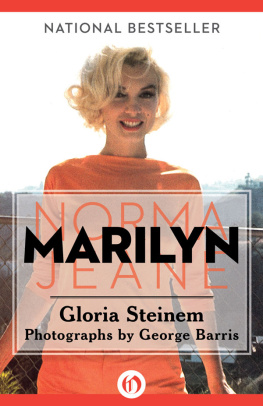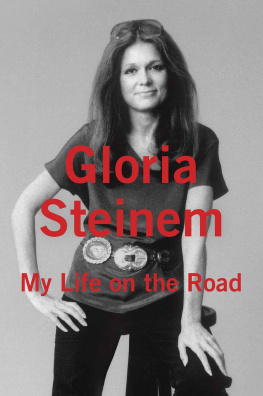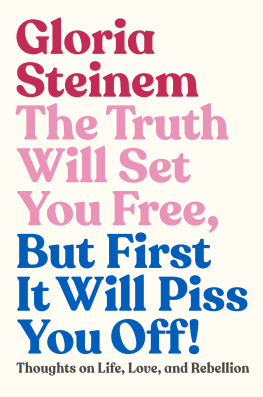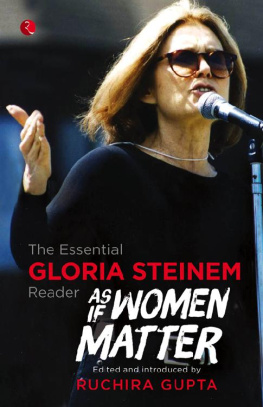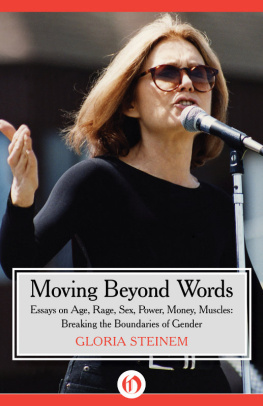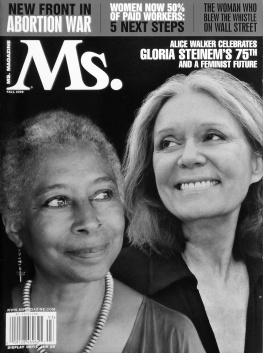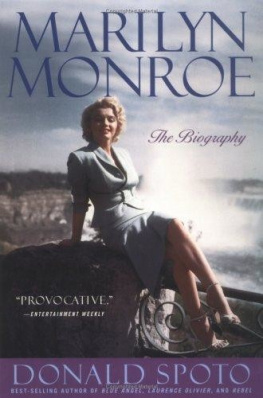Gloria Steinem - Marilyn
Here you can read online Gloria Steinem - Marilyn full text of the book (entire story) in english for free. Download pdf and epub, get meaning, cover and reviews about this ebook. year: 1988, publisher: Henry Holt & Co, genre: Non-fiction. Description of the work, (preface) as well as reviews are available. Best literature library LitArk.com created for fans of good reading and offers a wide selection of genres:
Romance novel
Science fiction
Adventure
Detective
Science
History
Home and family
Prose
Art
Politics
Computer
Non-fiction
Religion
Business
Children
Humor
Choose a favorite category and find really read worthwhile books. Enjoy immersion in the world of imagination, feel the emotions of the characters or learn something new for yourself, make an fascinating discovery.
- Book:Marilyn
- Author:
- Publisher:Henry Holt & Co
- Genre:
- Year:1988
- Rating:3 / 5
- Favourites:Add to favourites
- Your mark:
- 60
- 1
- 2
- 3
- 4
- 5
Marilyn: summary, description and annotation
We offer to read an annotation, description, summary or preface (depends on what the author of the book "Marilyn" wrote himself). If you haven't found the necessary information about the book — write in the comments, we will try to find it.
Marilyn — read online for free the complete book (whole text) full work
Below is the text of the book, divided by pages. System saving the place of the last page read, allows you to conveniently read the book "Marilyn" online for free, without having to search again every time where you left off. Put a bookmark, and you can go to the page where you finished reading at any time.
Font size:
Interval:
Bookmark:


This book is dedicated to the real Marilyn. And to the reality in us all.
Gloria Steinem
To a gentle, fragile Marilyn who will forever be in our hearts. Thanks for your friendship.
George Barris
THIS BOOK BEGAN WHEN George Barris, an American free-lance photojournalist who had been living in Paris for more than twenty years, decided to publish the many photographs he had taken of Marilyn Monroe in June and July 1962 in California. They were probably the last ever taken of her alive.
Together with a text for which he had completed only one long interview, they were to become a book, an illustrated biography that would, in Marilyns words, set the record straight; but this collaboration that she began on June 1, her thirty-sixth birthday, was never finished. Some of the photographs and quotes were used in newspaper reports after her death, but the book had been a joint project. George lost heart for it. In order to put some distance between himself and the sad sensationalism that followed her death, he moved to Paris. Once there, he met and married a French actress, Sylvie Constantine, became the father of two daughters who grew up there, and simply didnt come back. Over the years, some individual photos from those sessions were published, but most were not. Not until the approach of the twenty-fifth anniversary of Marilyn Monroes death did he revisit the original idea of a book.
I owe my part in it to Dick Seaver, president of Henry Holt and Company, who was looking for a writer to help explain Marilyn as an individual and as an icon of continuing power. Certainly, our new understanding of who women are has increased our fascination with who Marilyn might have been. The goal of this project, therefore, could and should be closer to that of feminism in general: to include the viewpoints and influence of both women and men, and thus to have a better chance of seeing one womans life as a whole. When Dick Seaver introduced me to George Barris, a gentle man who had been touched by Marilyns willingness to open a part of her life to him, as well as by the loss of her magical presence, I think we both recognized in each other an empathy for our subject.
Because this was the first time I had ever written a text to accompany photographs, I had one extra writerly hope. I wanted to find a way to give words some of the nonlinear pleasure that images have always had. After all, each photograph is complete and enjoyable in itself. It can make sense on its own, whether we look at just that one, or go through a collection back to front, or start in the middle, or just browse; yet many photos taken of one subject can still create a holograph in our minds eye. Thats why I have tried to write each chapter as an essay complete in itself. You may read about one aspect of Marilyns life that you feel connected to or curious about, or choose several, or proceed in reverse, or read straight through as in a conventional book (for there is also some chronology to the order of chapters). But hopefully, you will find a microcosm of Marilyns life in any one essay, and major themes will be repeated from different viewpoints in several essays, so that a factual and emotional holograph of a real person will begin to emerge.
George Barris and I shared one more idea: that this book might continue something that Marilyn herself cared about. When we discussed it, we realized that this something was clearly childrenespecially children who, like Marilyn as a child, needed more help, love, and protection than their own families could give. Almost everyone who saw Marilyn anywhere near children has remarked on the direct, emotional connection she had with them. Both at the times she did and at the times she did not want children of her own, she remained loyal and protective toward the children of her friends, and got special satisfaction from giving to an orphanage like the one where she had felt abandoned. Probably, she would have contributed more if she had paid attention to money or received a substantial percentage of the estimated $100 million that her films had earned when she died in 1962. (As a contract player, Marilyn received no more than $1,500 a week even when she was a big star, while other actresses who were her costarsfor instance, Jane Russell in Gentlemen Prefer Blondesmight receive five or six times more. The largest single sum mentioned in Marilyns will was only a $100,000 trust fund, part of which went to support Marilyns institutionalized mother.)
For many of us whose lives coincided with Marilyns, in reality or as a public image, her influence stretches both forward and backward.
For George Barris, this book began even before the taking of the photographs, or his current decision to publish them. It goes back to the fall of 1954, when he was assigned to photograph Marilyn Monroe while she filmed The Seven Year Itch. He stood with New York crowds as she was directed by Billy Wilder to repeat over and over again the famous scene in which air from a subway grating blows her white skirt high over her head, with the cameras eye inches away from her skin. (I hope this isnt for your private collection, to be shown in stag shows, Barris remembered her saying to Wilder. Later, when the most provocative shots were not in the finished movie, George wondered if she might have been right.) Standing with Walter Winchell was Marilyns then husband, Joe DiMaggio. When he could take the scene no more, DiMaggio just left. At a thank-you party Marilyn gave several days later for the cast and friends of the movie, George sat with her as she tried to track down Joe by phone, and talked tearfully about how lonely she was. It was the beginning of a friendship that was peripheral for Marilyn, but affected the course of Georges life. Indeed, when he brought his family back to California to live, the first thing his two teenage daughters, Caroline and Stephanie, wanted to see was where Marilyn was. He took them on a pilgrimage to Westwood Memorial Park, where Marilyns body rests in a wall crypt; she did not wish to be buried.
For me, this book began when, in 1953, as a teenager who loved all movies, I still walked out of Gentlemen Prefer Blondes in embarrassment at seeing this whispering, simpering, big-breasted child-woman who was simply hoping her way into total vulnerability. How dare she be just as vulnerable and unconfident as I felt? Three years later, I went briefly to the Actors Studio, where confident New York actors seemed to take pleasure in ignoring this great, powerful, unconfident movie star who had dared to come to learn. She sat by herself, her body hidden in a shapeless black sweater and slacks, her skin luminescent as she put her hands up to her face, as if trying to hide herself, and she gradually became a presence in the room, if only because the rest of the group was trying so hard not to look at her. I remember feeling protective toward this famous woman who was older and more experienced than I; a protectiveness explained by the endlessly vulnerable child who looked out of Marilyns eyes.
Wherever possible I have used her own words in this book. In addition to her interview with George Barris, I have quoted her from many sources, including her own unfinished autobiography, My Story, published from a manuscript she gave to business partner and friend Milton Greene. The confusing facts and stories of her early life were best researched by Fred Lawrence Guiles in
Next pageFont size:
Interval:
Bookmark:
Similar books «Marilyn»
Look at similar books to Marilyn. We have selected literature similar in name and meaning in the hope of providing readers with more options to find new, interesting, not yet read works.
Discussion, reviews of the book Marilyn and just readers' own opinions. Leave your comments, write what you think about the work, its meaning or the main characters. Specify what exactly you liked and what you didn't like, and why you think so.

